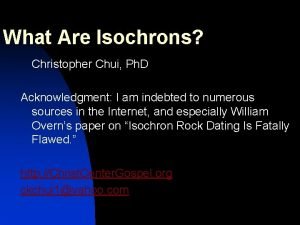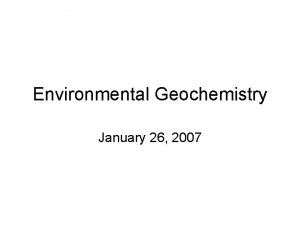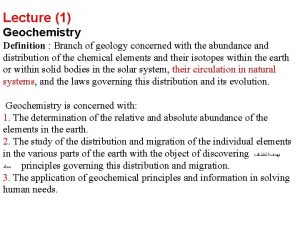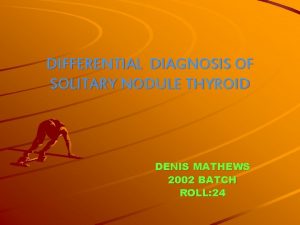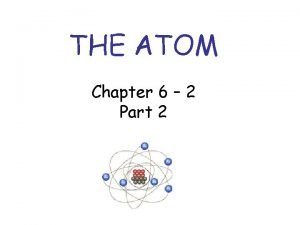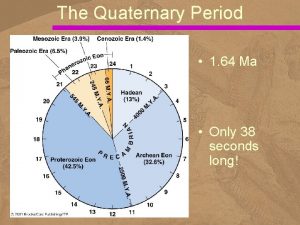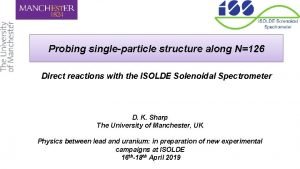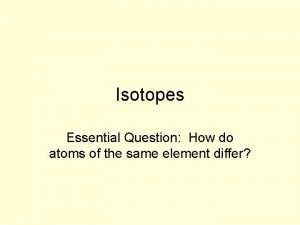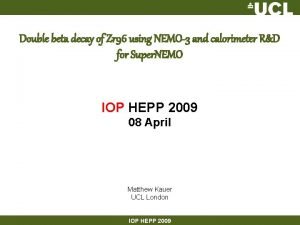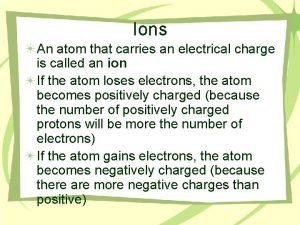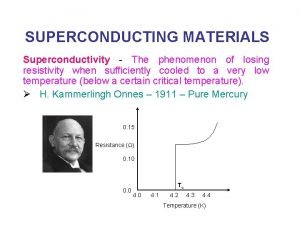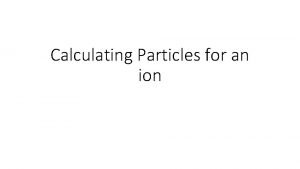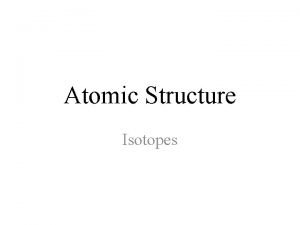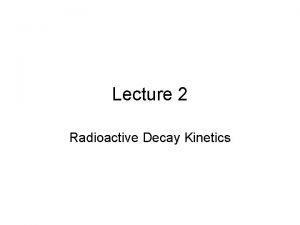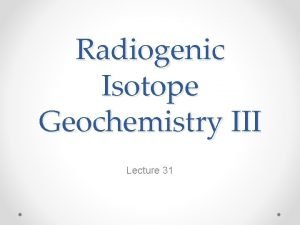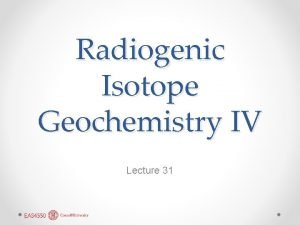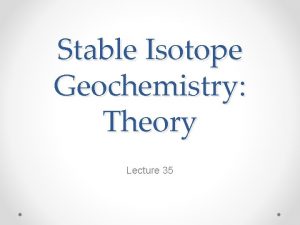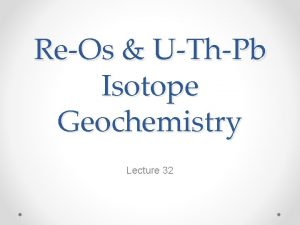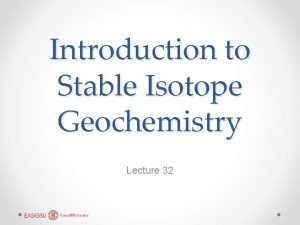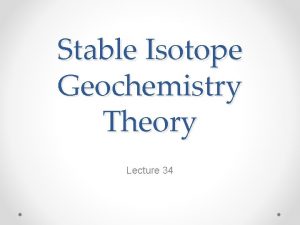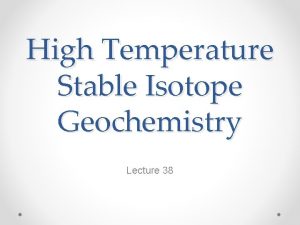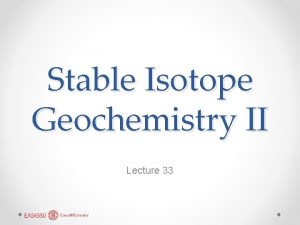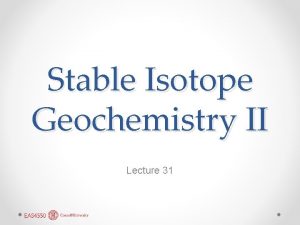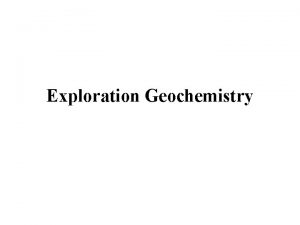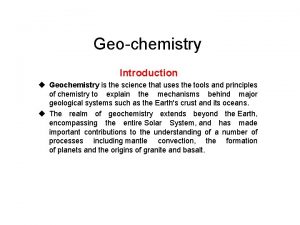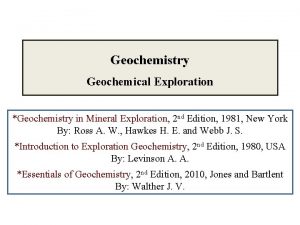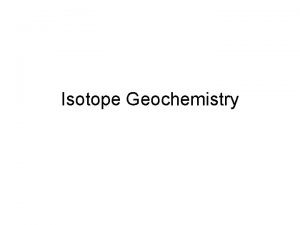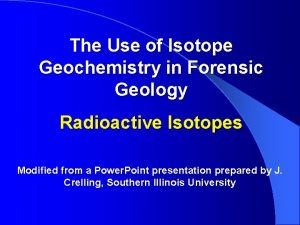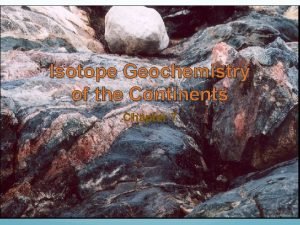Radiogenic Isotope Geochemistry II Lecture 29 Isochrons This























- Slides: 23

Radiogenic Isotope Geochemistry II Lecture 29

Isochrons • • • This equation has the form y = a + bx. Plotting the radiogenic isotope ratio against the parent daughter ratio, the intercept with be R 0 and the slope will be eλt -1. Since the slope is a function of time, it is called an isochron. We determine the slope statistically using linear regression (a more sophisticated form than usually used). From the slope, we easily solve for t: Most geochronology is based on this approach. Rb-Sr isochron for a achondritic meteorite. Individual points are individual minerals. t = 4. 57± 0. 02 Ga.

Isochrons • Assumptions inherent in geochronology: o o • All analyzed samples forming part of the isochron had the same radiogenic isotope ratio at t = 0. (System was in isotopic equilibrium). This is most likely to occur as a result of a thermal event (allowing for high diffusion rates) - so dating is restricted it igneous and metamorphic events. The system (and analyzed ‘subsystems’ such as minerals) remained closed to loss or gain of both parent and daughter since time 0. Accuracy and precision of the age depends on o o o Fit of the isochron (analytical, geological disturbance). Range of isotope (and parent-daughter) ratios - the greater the spread, the more accurate the age. Uncertainty in decay constant. Rb-Sr isochron for a achondritic meteorite. Individual points are individual minerals. t = 4. 57± 0. 02 Ga.

Isotope Geochemistry o The best summary statement of isotope geochemistry was given by Paul Gast in a 1960 paper: • In a given chemical system the isotopic abundance of 87 Sr is determined by four parameters: the isotopic abundance at a given initial time, the Rb/Sr ratio of the system, the decay constant of 87 Rb, and the time elapsed since the initial time. The isotopic composition of a particular sample of strontium, whose history may or may not be known, may be the result of time spent in a number of such systems or environments. In any case the isotopic composition is the timeintegrated result of the Rb/Sr ratios in all the past environments. Local differences in the Rb/Sr will, in time, result in local differences in the abundance of 87 Sr. Mixing of material during processes will tend to homogenize these local variations. Once homogenization occurs, the isotopic composition is not further affected by these processes. o This statement applies to other decay systems, many of which were ‘developed’ well after 1960.

Decay Systems

The Rb-Sr System • • • Both elements incompatible (Rb more so than Sr). Both soluble and therefore mobile (Rb more so than Sr). Range of Rb/Sr is large, particularly in crustal rocks (good for geochronology). Subject to disturbance by metamorphism and weathering. Both elements concentrated in crust relative to mantle - Rb more so than Sr. 87 Sr/86 Sr evolves to high values in the crust, low ones in the mantle.

Sr Isotope Chronostratigraphy • • We can’t generally radiometricly date sedimentary rocks, but there is an exception of sorts. 87 Sr/86 Sr has evolved very non-linearly in seawater. This is because the residence time of Sr in seawater is short compared to 87 Rb half-life, so 87 Sr/86 Sr is controlled by the relative fluxes of Sr to the oceans: o o • • • Rivers and dust from the continents The mantle, via oceanic crust and hydrothermal systems. Changes in these fluxes result in changes in 87 Sr/86 Sr over time. Sr is concentrated in carbonates precipitated from seawater. By comparing the 87 Sr/86 Sr of carbonates with the evolution curve, an age can be assigned. This quite accurate in the Tertiary (and widely used by oil companies), less so in earlier times.

The Sm-Nd System 147 Sm alpha decays to 143 Nd with a half-life of 106 billion years. Both are rare earths and behave similarly. In addition, 146 Sm decays to 142 Nd with a half-life of 68 103 million years. As a consequence of its short half-life, 146 Sm no longer exists in the solar system or the Earth. But it once did, and this provides some interesting insights.

Sm-Nd and εNd • Because Sm and Nd, like all rare earths, are refractory lithophile elements, and because their relative abundances vary little in chondritic meteorites, it is reasonable to suppose that the Sm/Nd ratio of the Earth is the same as chondrites. • This leads to a notation of 143 Nd/144 Nd ratios relative to the chondritic value, εNd: • While we usually use present-day values in this equation, we can calculate εNd (t) for any time, using the appropriate values for that time. • There are several advantages: o ε values are generally numbers between ~+10 and -20. o If the Earth has chondritic Sm/Nd, then the 143 Nd/144 Nd of the Earth is chondritic and εNd of the bulk Earth is 0 both today and at any time in the past. o The 142 Nd/144 Nd of the modern observable Earth differs from chondrites slightly (by about 20 ppm), which raises the question of whether the Earth’s Sm/Nd ratio is in fact exactly chondritic. The notation survives, however.

Sm-Nd Evolution of the Earth • Sm and Nd are incompatible elements (Nd more so that Sm). o • By converting to εNd, our evolution diagram rotates such that a chondritic uniform reservoir always evolves horizontally (εNd always 0). o • • Consequently, the crust evolves to low 143 Nd/144 Nd while the mantle evolves to high 143 Nd/144 Nd. The mantle evolves to positive εNd, the crust to negative εNd. Both Sm and Nd are insoluble and not very mobile, so it is in many ways a more robust chronometer than Rb-Sr. Unfortunately, the range in Sm/Nd ratios in crustal rocks is usually small, limiting the use of the system for geochronology.

Sm-Nd model ages or ‘Crustal Residence Times” • • A relatively large fractionation of Sm/Nd is involved in crust formation. But after a crustal rock is formed, its Sm/Nd ratio tends not to change. This leads to another useful concept, the model age or crustal residence time. From 143 Nd/144 Nd and 147 Sm/144 Nd, we can estimate the “age” or crustal residence time, i. e. , the time the rock has spent in the crust. We assume: o o o The crustal rock or its precursor was derived from the mantle The 147 Sm/144 Nd of the crustal rock did not change. We know how the mantle evolved. project the 143 Nd/144 Nd ratio back along a We line whose slope corresponds to the measured present 147 Sm/144 Nd ratio until it intersects the chondritic growth line. The model age is this age at which these lines intersect: o o CHUR model age (τCHUR). Depleted mantle model age is used (τDM). In either case, the model age is calculated by extrapolating the 143 Nd/144 Nd ratio back to the intersection with the mantle growth curve. Our isochron equation was: If we plot the radiogenic isotope ratio against t, then the slope is RP/Dλ. (note that x-axis label should be ‘age’, not t, in the sense of the equation).

Model Age Calculations • To calculate the model age, we note that the point where the lines intersect is the point where (143 Nd/144 Nd)0 of both the crustal rock and the mantle (CHUR or DM) are equal. • We write both growth equations and set the (143 Nd/144 Nd)0 values equal, then solve for t. • See Example 8. 3.

Sr-Nd Systematics of the Earth

Lu-Hf System • • 176 Lu decays to 176 Hf with a half-life of 37 billion years. Lu is the heaviest rare earth, Hf in the next heavier element. The Lu-Hf system is in many respects similar to the Sm-Nd system: o o o • • • (1) in both cases the elements are relatively immobile; (2) in both cases they are refractory lithophile elements; and (3) in both cases the daughter is preferentially enriched in the crust, so both 143 Nd/144 Nd and 176 Hf/177 Hf ratios are lower in the crust than in the mantle. Lu-Hf has two advantages: the half-life is shorter and the Lu/Hf ratio is much more variable. It has (had) one big disadvantage: before the advent of MC-ICP-MS, Hf isotope ratio measurements were very difficult to make. As a consequence, widespread use in geochemistry and geochronology really only began about 15 years ago. We can define a εHf notation by exact analogy to εNd: the relative difference from the chondritic value times 10000. εHf and εNd are usually strongly correlated. Lu concentrated in garnets, Hf excluded, so this system is particularly good for dating garnetbearing rocks. Hf is very similar to Zr and concentrated in zircon; Lu/Hf ratios are quite low. Zircon is widely used in Pb geochronology. Ages and initial ε Hf can be obtained from zircon analyses - this has been particularly interesting in very old crustal rocks.

The Re-Os System • • • 187 Re decays to 187 Os by β– decay with a half-life of 42 billion years. Unlike the other decay systems of geological interest, Re and Os are both siderophile elements: they are depleted in the silicate Earth and presumably concentrated in the core. The resulting very low concentration levels (sub-ppb) make analysis extremely difficult. Interest blossomed when a technique was developed to analyze Os. O 4– with great sensitivity. It remains very difficult to measure in many rocks, however. Peridotites have higher concentrations. The siderophile/chalcophile nature of these elements, making this a useful system to address questions of core formation and ore genesis. Os is a highly compatible element (bulk D ~ 10) while Re is moderately incompatible and is enriched in melts. For example, mantle peridotites have average Re/Os close to the chondritic value of 0. 08 whereas the average Re/Os in basalts is ~10. Thus partial melting appears to produce an increase in the Re/Os ratio by a factor of >102. As a consequence, the range of Os isotope ratios in the Earth is very large. The mantle has a 187 Os/188 Os ratio close to the chondritic value of, whereas the crust appears to have a a 187 Os/188 Os > 1. By contrast, the difference in 143 Nd/144 Nd ratios between crust and mantle is only about 0. 5%. The near chondritic a 187 Os/188 Os of the mantle is surprising, given that Os and Re should have partitioned into the core very differently. This suggests most of the noble metals in the silicate Earth are derived from a late accretionary veneer added after the core formed. In addition, 190 Pt decays to 186 Os with a half-life of 650 billion years. The resulting variations in 186 Os/188 Os are small.

Os Isotopes in the SCLM • Since the silicate Earth appears to have a nearchondritic 187 Os/188 Os ratio, it is useful to define a parameter analogous to εNd and εHf that measures the deviation from chondritic. γOs is defined as: • Studies of pieces of subcontinental lithospheric mantle xenoliths show that much of this mantle is poor in clinopyroxene and garnet and hence depleted in its basaltic component. Surprisingly, these xenoliths often show evidence of incompatible element enrichment, including high 87 Sr/86 Sr and low εNd. This latter feature is often attributed to reaction of the mantle lithosphere with very small degree melts percolating upward through it (a process termed “mantle metasomatism”). This process, however, apparently leaves the Re-Os system unaffected, so that 187 Re/188 Os and 187 Os/188 Os remain low. Low γOs is a signature of lithospheric mantle. • •

Os Isotopes in Seawater • Os isotopes in seawater (tracked by measuring Os in Mn nodules and black shales) reveals a variation much like that of 87 Sr/86 Sr. • The reflects a balance of mantle and crustal inputs. • And, perhaps, meteoritic ones. Very low ratios occur at the KT boundary. Ratio was already decreasing before then: Deccan traps volcanism? (supports the hit ‘em while their down theory of the K-T extinction).

U-Th-Pb • In the U-Th-Pb system there are three decay schemes producing 3 isotopes of Pb. Two U isotopes decay to 2 Pb isotopes, and since the parent and daughter isotopes are chemically identical, we get a particularly powerful tool. • Following convention, we will designate the 238 U/204 Pb ratio as μ, and the 232 Th/238 U ratio as κ. We can write two versions of our isochron equation: o Conventionally, the 235 U/238 U was assumed to have a constant, uniform value of 1/137. 88. Recent studies, however, have demonstrated that this ratio varies slightly due to kinetic chemical fractionation. Consequently, for highest precision, it should be measured. In most cases, however, we can use the revised apparent average value of 1/137. 82.

Pb-Pb isochrons • These equations can be rearranged by subtracting the initial ratio from both sides. For example: • Dividing the two: o • • the 235 U/238 U is the present day ratio and assumed constant. The left is a slope on a plot of 207 Pb/204 Pb vs 206 Pb/204 Pb. Slope is proportional to time, and so is an isochron. The value is that we need not know or measure the U/Pb ratio (which is subject to change during weathering).

Pb Isotopic Evolution • • Because the half-life of 235 U is much shorter than that of 238 U, 235 U decays more rapidly and Pb isotopic evolution follows curved paths on this plot. o The exact path depends upon µ. All systems that begin with a common initial isotopic composition at time t 0 lie along a straight line at some later time t. This line is the Pb-Pb isochron. When the solar system formed 4. 57 billion years ago, it had a single, uniform Pb isotope composition. We assume that bodies such as the Earth have remained closed since their formation. Pb in each planetary body would evolve along a separate path that depends on µ of that body. At any later time t, the 207 Pb/204 Pb and 206 Pb/204 Pb ratios of all bodies plot on a unique line, called the Geochron, which has a slope corresponding to the age of the solar system, and passing through ‘primordial Pb’. o True only for the planet as a whole, not individual rock formations. The Earth as a whole must fall on this line if it formed at the same time as the solar system with the solar system initial Pb isotopic composition. o o The problem is that Earth may be 100 Ma younger than the ‘solar system’ - because it took a long time to form large terrestrial planets. There is some flexibility in the exact position of the geochron because the age is not exactly known.

232 Th-208 Pb • We can combine the growth equations for 208 Pb/204 Pb and 206 Pb/204 Pb in a way similar to our 207 Pb-206 Pb isochron equation We end up with: o where κ is the 232 Th/238 U ratio. • The left is a slope on a plot of 208 Pb/204 Pb vs 206 Pb/204 Pb and is proportional to t and κ. o assuming κ has been constant (except for radioactive decay).

Pb Isotope Ratios in the Earth

Pb Isotope Ratios in the Earth • • Major terrestrial reservoirs, such as the upper mantle (represented by MORB), upper and lower continental crust, plot near the Geochron between growth curves for µ = 8 and µ = 8. 8, suggesting µ of the Earth ≈ 8. 5. If a system has experienced a decrease in U/Pb at some point in the past, its Pb isotopic composition will lie to the left of the Geochron; if its U/Pb ratio increased, its present Pb isotopic composition will lie to the right of the Geochron. U is more incompatible than Pb, so incompatible element depleted reservoirs should plot to the left of the Geochron, enriched ones to the right. From the other isotopic ratios, we would have predicted that continental crust should lie to the right of the Geochron and the mantle to the left. Surprisingly, Pb isotope ratios of mantle-derived rocks also plot mostly to the right of the Geochron. This indicates the U/Pb ratio in the mantle has increased, not decreased as expected. This phenomenon is known as the Pb paradox and it implies that a simple model of crust–mantle evolution that involves only transfer of incompatible elements from crust to mantle through magmatism is inadequate. There is also perhaps something of a mass balance problem - since everything should average out to plot on the Geochron.
 Dr chris chui
Dr chris chui Msc marine biogeochemistry
Msc marine biogeochemistry What is geochemistry in geology
What is geochemistry in geology What is ionic radii
What is ionic radii 01:640:244 lecture notes - lecture 15: plat, idah, farad
01:640:244 lecture notes - lecture 15: plat, idah, farad Rule of 12 in thyroid
Rule of 12 in thyroid Whats an isotope.
Whats an isotope. What is isotopes
What is isotopes Oxygen isotope ratio
Oxygen isotope ratio Pb-208 isotope
Pb-208 isotope Steps for calculating average atomic mass
Steps for calculating average atomic mass Proton fun fact
Proton fun fact Stable vs unstable isotope
Stable vs unstable isotope Isotope
Isotope What does the atomic number represent
What does the atomic number represent Zr-96 isotope
Zr-96 isotope Function of thyroxin
Function of thyroxin An atom that carries an electrical charge is
An atom that carries an electrical charge is Persistent current in superconductor
Persistent current in superconductor Hydrogen isotope
Hydrogen isotope Acetylferrocene
Acetylferrocene Iron isotope notation
Iron isotope notation Ký hiệu proton
Ký hiệu proton Radioactive decay equation
Radioactive decay equation
